Is It Caused By Muscle Tension or Bone Length?
Author: Julie Donnelly, LMT – The Pain Relief Expert
Editor: Dr. Steve Chaney
Short Leg Syndrome is a condition where one leg is shorter than the other. This leg length discrepancy frequently causes a long list of aches and pains from the neck to the feet. However, is your leg actually shorter, or is it just pulled up into your pelvis and appearing to be shorter?
You need to have x-rays and measure the bones to prove that they are different lengths. If the bones prove to be the same length, then muscles are the cause and you can use the short leg syndrome treatment we will discuss here.
I received a message from a concerned father about his son, a dedicated teenage athlete. His son plays sports despite the pain in his tight hamstrings and having short leg syndrome. His message read:
My son has been suffering from tight hamstrings from the age of about 12. He played on regardless as he was an exceptional player and the team needed him. He was told by a physician to do stretching for his hamstrings, but it has persisted. We have noticed that one leg is shorter. He now plays football and does boxing and is very fit, but he is suffering very tight and sore hamstrings. The pain is lower on left and high near to the Gluteus Maximus on the right leg.
Why Muscles Can Cause Short Leg Syndrome
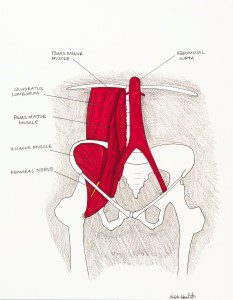 Short leg syndrome commonly happens when the muscles that insert into the top of the thigh bone (femur) become tight. When the muscles go into a spasm (knot) or a contraction (shorten) they pull UP on the bone.
Short leg syndrome commonly happens when the muscles that insert into the top of the thigh bone (femur) become tight. When the muscles go into a spasm (knot) or a contraction (shorten) they pull UP on the bone.
In the case of the psoas and iliacus muscles, they will be pulling the thigh bone up toward the pelvis.
The tension in these two muscles not only cause short leg syndrome but a list of other conditions. You may also have a pelvis rotation which causes overstretched hamstrings, sciatica, groin pain, knee pain, and low back pain.
It gets complicated because the pelvis rotation causes one of the thigh muscles to shorten pulling your pelvis DOWN in the front. While all this is happening, your thigh bone is being pulled UP, giving the symptoms of short leg syndrome.
Meanwhile, muscles in the back of your body are having to compensate for the pelvis rotation. Which brings me to the gluteus maximus, the thick and strong muscle of your butt. This muscle also inserts into the top of your thigh bone. When the gluteus maximus is tight, it pulls up on the thigh bone, drawing it toward your pelvis. 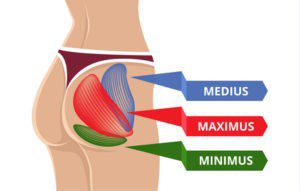 Another cause for the appearance of short leg syndrome.
Another cause for the appearance of short leg syndrome.
The three gluteal muscles all insert into the top of your thigh bone and pull it up toward the pelvis.
This action is required in order to walk. However, when any of the muscles are in spasm, they pull your thigh bone toward the pelvis.
The last muscle we’ll discuss that causes the symptoms of short leg syndrome is the tensor fascia lata. This muscle goes from the outside of your pelvis and inserts into the top of your thigh bone. The tendon, called the iliotibial band (ITB), continues down and inserts into the outside of your knee.
Since the tensor fascia lata inserts into the top of your thigh bone it can cause short leg syndrome.
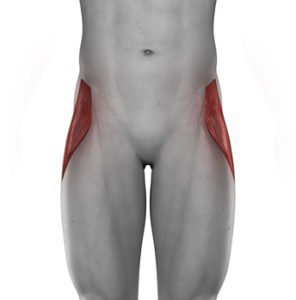 The tensor fascia lata muscle merges into your ITB and inserts into your knee. When it is shortened by a spasm, you will feel tight along the outside of your thigh. Many people complain about a tight ITB and rub their leg, but it’s really the tensor fascia lata muscle that is in spasm.
The tensor fascia lata muscle merges into your ITB and inserts into your knee. When it is shortened by a spasm, you will feel tight along the outside of your thigh. Many people complain about a tight ITB and rub their leg, but it’s really the tensor fascia lata muscle that is in spasm.
Your tensor fascia lata muscle needs to be released to stop knee pain, hip pain, and short leg syndrome.
Are The Hamstrings Involved In Short Leg Syndrome?
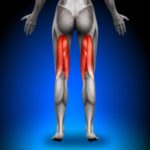 No, not really. Although, the pelvis rotation is involved in hamstring pain. As your pelvis is going down in the front and up in the back, it will cause your hamstrings to overstretch.
No, not really. Although, the pelvis rotation is involved in hamstring pain. As your pelvis is going down in the front and up in the back, it will cause your hamstrings to overstretch.
It is easy to imagine what would happen if the hamstrings were being overstretched. Pain is felt at the top of the muscle, along the bone, and also behind the knee.
Stretching or treating the spasms that are common in hamstrings, would be a potential cause for further injury.
The hamstrings should always be treated last to prevent the muscle fibers from stretching further.
Short Leg Syndrome Treatment Made Easy
As I mentioned, there are many muscles involved in short leg syndrome treatment. For the sake of time and length, this blog will only support one treatment. However, this treatment is important and it will give benefits to other problems, including short leg syndrome.
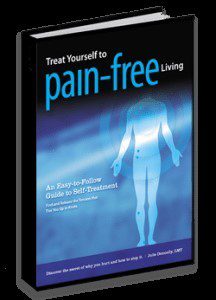 An easy self-treatment is to lie on a ball. You can also do this standing up and leaning into a wall.
An easy self-treatment is to lie on a ball. You can also do this standing up and leaning into a wall.
In my book, Treat Yourself to Pain Free Living, I teach how to treat all the muscles involved in short leg syndrome.
Short leg syndrome is a term to describe the problem, but the source of the pain is often overlooked. It will benefit you to explore the muscle involvement before you opt for expensive orthotics or medical treatments.
Julie Donnelly
About The Author
Julie Donnelly is a Deep Muscle Massage Therapist with 20 years of experience specializing in the treatment of chronic joint pain and sports injuries. She has worked extensively with elite athletes and patients who have been unsuccessful at finding relief through the more conventional therapies.
She has been widely published, both on – and off – line, in magazines, newsletters, and newspapers around the country. She is also often chosen to speak at national conventions, medical schools, and health facilities nationwide.
These statements have not been evaluated by the Food and Drug Administration. This information is not intended to diagnose, treat, cure or prevent any disease.

